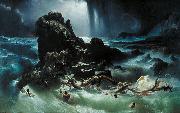All Francis Danby's oil paintings


|
|
|
| ID |
Image |
Oil Pantings, Sorted from A to Z |
Other Information |
| 91240 |
 |
Liensfiord [possibly Lifjord, a part of Sognefjord |
1841(1841)
Medium oil on canvas
Dimensions 82,5 x 117 cm
cjr |
| 74541 |
 |
See bei Sonnenuntergang |
c. 1835
Oil on canvas
: 46 X 61 cm
cjr |
| 76091 |
 |
See bei Sonnenuntergang |
Deutsch: um 1835
English: c. 1835
Medium Oil on canvas
Dimensions Deutsch: 46 ?? 61 cm
cyf |
| 28222 |
 |
The Deluge |
c 1840
Oil on canvas 28.4 x 451.6 cm (112 x 178m)
|
| 66301 |
 |
The Deluge |
The Deluge, oil painting in the Tate Gallery, London
1837-1839
|
| 94578 |
 |
The Deluge |
circa 1840(1840)
Medium oil on canvas
Dimensions Height: 707 cm (278.3 in). Width: 1,099 cm (432.7 in).
cjr |
| 94577 |
 |
View of the Avon Gorge |
1822(1822)
cjr |
|
|
| Francis Danby
|
| Irish Painter, 1793-1861
was a British painter of the Romantic eraBorn in the south of Ireland, he was one of a set of twins; his father, James Danby, farmed a small property he owned near Wexford, but his death, in 1807, caused the family to move to Dublin, while Francis was still a schoolboy. He began to practice drawing at the Royal Dublin Society's schools; and under an erratic young artist named James Arthur O'Connor he began painting landscapes. Danby also made acquaintance with George Petrie, and all three left for London together in 1824. This expedition, undertaken with very inadequate funds, quickly came to an end, and they had to get home again by walking. At Bristol they made a pause, and Danby, finding he could get trifling sums for water-color drawings, remained there working diligently and sending to the London exhibitions pictures of importance. There his large oil paintings quickly attracted attention. Danby painted "vast illusionist canvases" comparable to those of John Martin of "grand, gloomy and fantastic subjects which chimed exactly with the Byronic taste of the 1820s."The Upas Tree (1820) and The Delivery of the Israelites (1825) brought him his election as an Associate Member of the Royal Academy. He left Bristol for London, and in 1828 exhibited his Opening of the Sixth Seal at the British Institution, receiving from that body a prize of 200 guineas; and this picture was followed by two others on the theme of the Apocalypse. In 1829 Danby's wife deserted him, running off with the painter Paul Falconer Poole Danby left London, declaring that he would never live there again, and that the Academy, instead of aiding him, had, somehow or other, used him badly. For a decade he lived on the Lake of Geneva in Switzerland, becoming a Bohemian with boat-building fancies, painting only now and then. He later moved to Paris for a short period of time. He returned to England in 1840, when his sons, James and Thomas, both artists, were growing up. Danby exhibited his large (15 feet wide) and powerful The Deluge that year; the success of that painting, "the largest and most dramatic of all his Martinesque visions, revitalized his reputation and career. Other pictures by him were The Golden Age (c. 1827, exhibited 1831), Rich and Rare Were the Gems She Wore (1837), and The Evening Gun (1848). Some of Danby's later paintings, like The Woodnymph's Hymn to the Rising Sun (1845), tended toward a calmer, more restrained, more cheerful manner than those in his earlier style; but he returned to his early mode for The Shipwreck (1859).
. Related Artists to : | Edward Armitage | Louis Hayet | Armand Palliere | Arkhip Kuinji | velazqufz | |

|
|

|
|